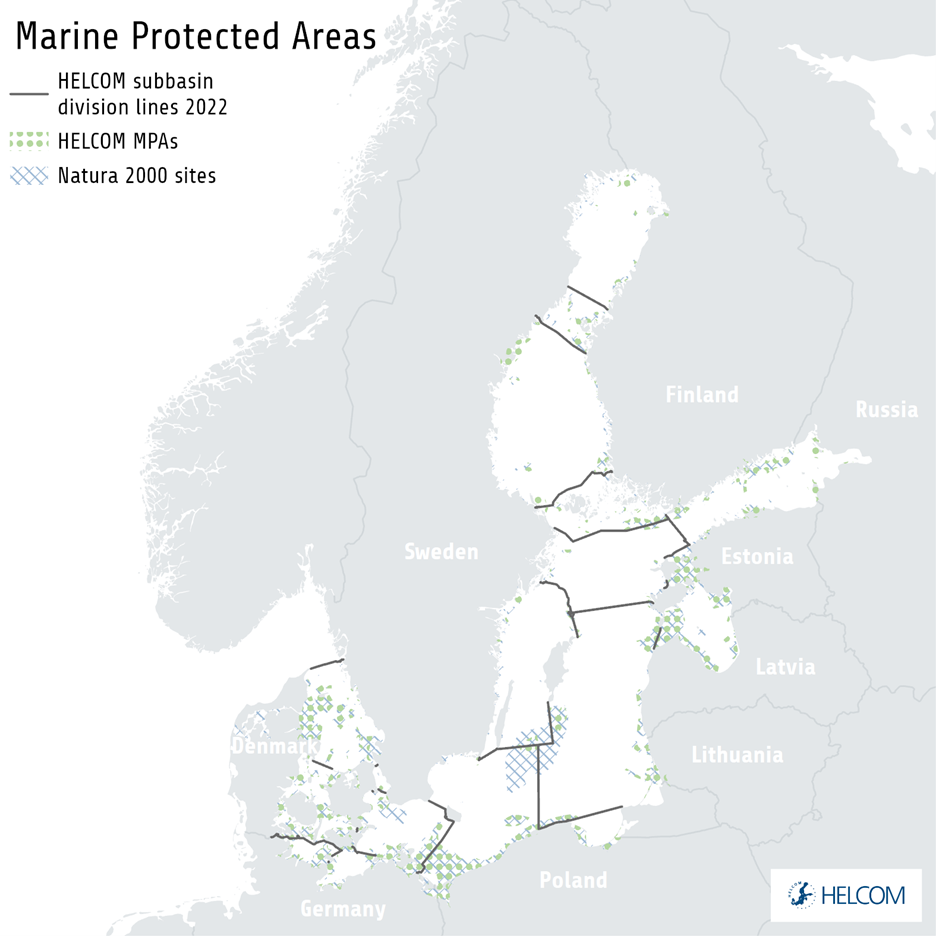Baltic Sea basin and Vistula Lagoon/Southern Baltic#
Q 25 - How to integrate the process of MPA designation or extension in MSP?
Q 27 - Are there good practices of MPA-MSP integration in terms of governance?
Q 54 - How to anticipate and address climate change within MPA?
Q 53 - How to identify and analyze the main conflict areas between human uses and the environment?
Q 41 - What are the main objectives and elements of monitoring programs for MPAs?
Description#
The Baltic Sea, a semi-enclosed inland sea located in Northern Europe, serves as a transboundary sea basin. The sea area is 377,000 km² and stretches from 53°N to 66°N latitude and from 10°E to 30°E longitude. Its clear separation from the open ocean restricts water movement through the Danish Straits. Eight EU coastal countries share the Baltic coast (i.e., Germany, Denmark, Sweden. Finland, Estonia, Latvia, Lithuania and Poland) with Russia. The Baltic is one of the most brackish bodies of water in the world, receiving both ocean and river influx water. The average salinity of the Baltic Sea is around 7%. The Baltic Sea’s ecosystem is particularly sensitive, responding quickly to external influences and pressures. Natural occurrences, such as environmental factor fluctuations, and anthropogenic effects, such as fisheries, pollution, or industrialization impact the sea measurably. The Baltic Sea features a fragile ecosystem under multiple human-induced environmental pressures, both on land and at sea. There is not a wide variety of sea life in the Baltic Sea in comparison with the sea basins located more to the south. It is possible to find algae, but flowering plants are less common. Fish are the dominant animal species, such as herring, cod, sprat, flounder, mackerel, flatfish, salmon and eel, but their population has drastically diminished recently. Occasionally large marine mammals can be found – porpoises and seals, which are under protection. The most common birds are terns, gulls and mute swans. There are also jellyfish, annelids (worms), small shellfish and crustaceans. The ecological status of the Baltic Sea waters is unsatisfactory. Influx of town and industrial sewage, as well as artificial fertilisers and pesticides washed out from fields results in eutrophication of marine waters. There are also accidents that result in fuel or other liquids leaking into the water since the Baltic Sea is one of the busiest sea basins in the world in terms of sea traffic. There are many wrecks and remnants of the Second World War that remain on the seabed. Key economic sectors are fisheries, aquaculture, tourism, renewables and mineral extraction. Conservation efforts are coordinated by the Helsinki Commission (international convention) since 1974. Gdansk Bay, located in the southern Baltic Sea, is highlighted as an ecologically diverse area that supports a wide range of marine species and human activities such as fishing, shipping, and recreation. The task focus was on identifying and analysing potential conflicts arising from the proposed expansion of Marine Protected Areas (MPAs) to protect sensitive habitats, ensure ecological connectivity, and preserve valuable environmental assets. The potential conflicts with tourism, bottom trawling, coastal fishery, and shipping are outlined as areas of concern. The key characteristics of the test site are following: Transboundary sea basin; Ecosystem under multiple human-induced pressures; Need for more designated MPAs to achieve the regional goals; Need for coordinated plans for human activities.

Sources
Matczak et al. (2024) Test Sites Methodology Including the Participation Strategy (Deliverable – D5.2., under the WP5 of MSP4BIO project (GA n° 101060707)).